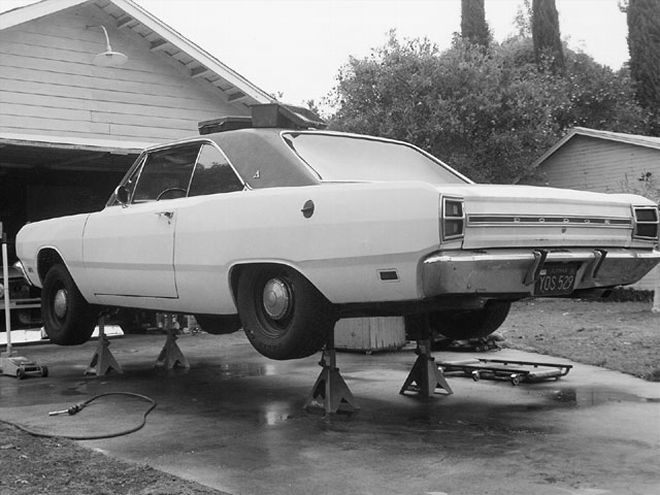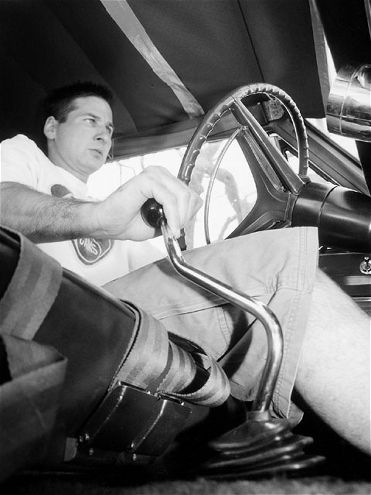
 After we scored a complete short-extension four-speed setup from a junked late-'70s 318 F-Body, plus a set of A-Body swing pedals at a swap meet, we were ready to work on our Dart. Find a good place to work; this'll take awhile. Get a set of good H/D high-lift jackstands and raise the car for working clearance. Next, the automatic comes out. This 727 was nice and strong, but there's nothing like banging gears with your right fist.
After we scored a complete short-extension four-speed setup from a junked late-'70s 318 F-Body, plus a set of A-Body swing pedals at a swap meet, we were ready to work on our Dart. Find a good place to work; this'll take awhile. Get a set of good H/D high-lift jackstands and raise the car for working clearance. Next, the automatic comes out. This 727 was nice and strong, but there's nothing like banging gears with your right fist.
"Four On The Floor."
If there's anything that captures the soul of a pure, old-style musclecar, it's banging out shifts with a four-speed manual transmission. No doubt the Torqueflite is good, arguably the best automatic of the supercar era, but for all-out power-shifting brutality, that four-change took the prize. Perhaps it's that deeper level of mechanical connection that comes with hand-grabbing gears that can't be matched by a juice-shifted box. Like their automatics, Chrysler's A-833 manual transmissions were the best of the breed, designed from the start to survive on the strip behind the thinly disguised race engines the company was noted for. To quote the factory literature, "... it is still the strongest, most dependable, four-speed production transmission available in assembly-line built passenger cars."
Got a hankering for a cold chrome stick snaking up from the center of the floorboard yourself, but your Mopar left the factory a pedal short? The change can be made. Be forewarned, however, that this transformation is not for the weak of heart or mechanical ability. In fact, the MP Chassis Book warns, "The conversion of an automatic transmission car to a manual transmission is extremely complicated and not recommended." For purists of originality, such a swap may even be perceived as malfeasance, especially on a rare or historically significant vehicle.

That behind us, my modified daily driver '69 Dodge Dart Custom is neither rare nor historically significant, and it was already carrying a modified 727 TorqueFlite with a high-stall in place of the stock 904. Why mess with a good thing? You can make all the excuses you want about the better fuel economy, quicker times in the quarter, or available overdrive ratios-the truth is that the seduction of grabbing gears in a hot small-block Mopar was reason enough.
In reality, the list of what's needed to make the change is not that long: a pedal set; clutch linkage; clutch disc, pressure plate, and throwout bearing; the bellhousing and trans; a shifter and linkage; the floor tunnel hump; four-speed carpeting; and maybe a steering column. The tricky part is amassing the parts required, with the key being compatibility. For it to work, the four-speed tranny system has to have the right players on the team in your conversion. The clutch has to be the right size for the flywheel, the pedals have to be correct for the body type, the flywheel and tranny pilot have to fit the bellhousing, and the list goes on.
As you might guess, there were many variations; unfortunately too many to cover them for every application here. The best bet is to source the conversion pieces from a single compatible donor vehicle of the same body type, buy the pieces from a specialist such as Brewer's, or just know your four-speed stuff cold when shopping the boneyards and swap meets. The Mopar Chassis Book has an excellent chapter on four speeds that covers most of the parts variations you need to know if buying the conversion parts a-la-carte.
In our case, we found an F-Body short-extension overdrive 833 four-speed in an Aspen R/T at the junkyard. The 318 four-speed car was complete, yielding a mother lode of conversion pieces. For our A-Body application, the F-Body's short-extension tranny, bellhousing, shifter and linkage, flywheel and clutch, and shift fork were a direct interchange. We pulled the clutch linkage as well, which wasn't an ideal match for the A-Body chassis, but beggars can't be choosers. We knew with some minor, though well-thought-out changes, we could probably adapt the linkage and fabricate the rest of what we'd need (if hammer forging your own linkage parts against an anvil isn't your game, get the correct pieces for your specific application). We had already pack-ratted the correct A-Body pedals from a local car-show swap meet, so the only parts missing when we got ready to start were the tunnel hump and carpet, easily obtained by calling Sherman & Associates for the hump, and Auto Custom Carpet for the rug. The only thing between us and tire-screeching shifts was to break out the cutter, welder, and wrenches, and cram it in. Here's how we did it.